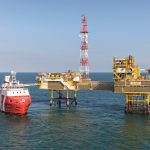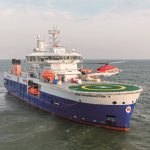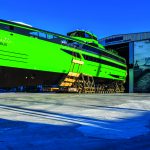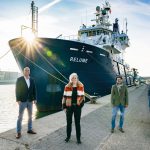Three men and a lady
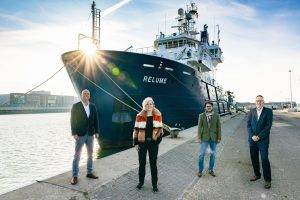
From left to right: David Stibbe, Sylvia Boer, Wim Schouwenaar and Jo Peters. Photo courtesy of Tijmen Kielen.
The perfect storm. A Porsche for the price of a Polo. Autistic sustainability. No, these aren’t the names of a new game show. They’re just a few of the strong opinions expressed during a discussion on the future of oil & gas organised by AYOP.
With the end of the fossil fuel era drawing near, the future of oil & gas is a critical theme. But how does the industry feel about the situation? Sylvia Boer, Director of Amsterdam IJmuiden Offshore Ports (AYOP), posed this question to Wim Schouwenaar (CEO of DHSS), Jo Peters (Secretary General of NOGEPA), and David Stibbe (Director Business Development & Marketing Intelligence, about the future of oil & gas. Spoiler alert: the three men were largely in agreement and didn’t hold back. The general consensus… “It’s never been this bad before.”
Sylvia: “Gentlemen, to get things started: your initial thoughts on the future of oil & gas?”
Jo: “I can summarise them in one word: valuable. Firstly, it would be smartest to remove all the oil and gas that remains in the ground rather than go knocking on Putin’s door. Secondly, we have a significant amount of knowledge and an infrastructure that could easily be used for the systems of the future such as geothermal energy, and for activities such as CCS. It would be really foolish to break down all the pipelines and platforms only to have to re-install them again later.”
David: “Future? Sure. I honestly think it’s something the entire chain should be considering. The role we play in this regard is mainly focused on creating sustainable maritime solutions. For the future and for the sector. Our crew boat portfolio is a great example. Here, we don’t only focus on issues like emissions, we aim primarily for economic sustainability: cost reductions and efficiency. These are the things we need in order to keep the approximately 20 years we have left attractive to everyone.”
Wim: “We’ve also started preparing for the future. Recently we signed a hoisting-helicopter contract with an offshore wind player in which we shared the operational aspects with an oil & gas provider. We want to see where we can achieve synergies and better utilisation. Rather than fly back empty after dropping a team on an offshore turbine, we’ll be shuttling between platforms in the same area. As well as allowing us to fulfil the logistical needs of both parties, we can also offer them cost savings of up to 50%. Pure profit. We hope to start a pilot project soon that will bring the two industries closer together. DHSS will be supervising.”
Sylvia: “One could draw the conclusion that oil & gas and wind are already sitting around the same table?”
Jo: “Certainly, that started around five years ago based on the growing insight that greater synergy on the North Sea was desirable. This resulted in the North Sea Energy initiative in which we work with the wind sector and TNO to develop an integrated approach and realise a collaboration and exchange of facilities for safety, logistics and cost savings.”
David: “This absolute distinction between what used to be two completely different worlds has become obsolete. We see this too. For instance, the Service Operations Vessel method we designed for the offshore wind sector was also welcomed by oil & gas – with a few minor adaptations of course. They loved it.”
Jo: “The teamwork is not just at the top, it’s increasingly moving down to the operational level. While we used to say the wind people should stay as far away from us as possible, we now say, come closer, we want to reduce our CO2 emissions and need your power to do so.”
Sylvia: “Can oil & gas help the new energy forms forward in any way? In the field of CCS, for instance?”
Jo: “I don’t think anyone would object. Okay, there may still be some dogmatic people around who think we should wait until there is a final answer. But why? The longer we wait, the more CO2 emissions we produce. As a temporary solution perhaps? No, obviously not. If there is already a complete infrastructure in place to pump CO2 to empty gas fields, why wouldn’t you use it permanently – leading to negative emissions – once our industry has become fully bio-based? I mean, we have empty gas fields and we have platforms. The only thing we don’t have is electricity, but that’s just a matter of connecting the platforms to the windfarms.”
Wim: “Precisely.”
Jo: “I think every new platform will become wind-electric. You won’t get a license otherwise. And the use of existing platforms should be determined on a case-by-case basis.”
Sylvia: “We have to be realistic and tell a clear story.”
David: “Indeed, we have to be realistic and tell a clear story. Everyone’s constantly talking about carbon footprint reduction. The ambitions in that regard might be clear but not everything is technically possible (yet). We are obviously doing what we can via digital route optimisation and the use of sustainable fuels such as Good Fuel, for instance, but full electric sailing is unfeasible at this point. We have to find the right balance between ambition and feasibility. But please, let’s just keep our feet on the ground.”
Jo: “I’d like to add that there are people who have all the right intentions but are – as I call it – autistically sustainable. They believe that since we are cutting down on gas consumption, everything should be dismantled immediately. But the energy transition can only be realised quickly if you involve the entire system, have a clear view of the end result and define the required route in a smart way. If you don’t, chances are things will go badly. And if things do work out, it would be enormously expensive.”
Sylvia: “You’re saying that the pressure from the big bad world outside is significant, while the knowledge is relatively limited. How do you manage all these expectations?”
Wim: “As David said, the difficulty lies in the story. It has to be told correctly. Simply put, in the coming years North Sea gas will be essential for the transition to new forms of energy. We simply don’t yet have enough to meet the entire energy demand of the Netherlands.”
Jo: “Glad you brought it up…”
David: “It is especially important to communicate a realistic timeline to politicians and environmental organisations. You have no idea how much time it takes me sometimes to explain what is and isn’t possible. And then I hear someone say I want 50% less CO2 emissions for the same price, and I think: well I wouldn’t mind a Porsche for the price of a Polo either, but it just isn’t realistic. An integrated, cohesive and truthful story is essential for everyone involved in this subject.”
Sylvia: “This is directly related to your business, isn’t it? How do current developments influence that? I mean COVID-19, the US election, the low oil & gas prices?”
Wim: “Luckily, some of our oil and gas clients also started working in wind. We automatically joined them. And it went quickly, I must say! Especially after we established our facilities in Eemshaven. Since the first offshore windfarms appeared off the coast of IJmuiden, Eemshaven has become the next hotspot. Logistically, the large roll-out of wind at sea actually started there. From Eemshaven we now work for several major players that are active in both markets and will participate in the expansion of new windfarms in the west too. This is important to IJmuiden and Den Helder. All in all, we were able to compensate for the downturn in oil & gas thanks to our involvement in wind. As a provider of helicopter services and as a shipping agent. But you can assume that companies which depend solely on oil & gas are struggling.”
Jo: “That’s an understatement. In the nearly 40 years I’ve been in this business I’ve never seen it this bad. We are in a perfect storm. Not only have we been dealing with low oil and gas prices over a long period, we’ve also faced an investment climate that is lagging far behind the surrounding countries. The tax rebate that was supposed to go from 25% to 40% has still not been dealt with by the Dutch parliament so we are losing out to countries like Norway and the UK.”
Wim: “There is no level playing field.”
Jo: “Exactly. Add to that the millions of investments kept on the shelf because our activities in the North Sea are said to have a harmful effect on an area south of Maastricht. Absolutely ridiculous! And then we’re going to be faced with the national CO2 tax. Let me spare you the details, but it comes down to the fact that – without the sector having any influence whatsoever – this will cost us more than what the proposed increase in tax rebates would bring in. And then we haven’t even started on the operational issues caused by COVID-19. The only conclusion I can draw is that we are at the heart of an unparalleled storm. The industry is fighting to survive. The only benefit is that things are now so bad that they can only get better.”
David: “Shall I try to put a positive spin on the issue? It is indeed a problem for oil & gas on the North Sea. The matter is slightly different for our global market focus. Put another way, it’s not as bad. Take the new crew boat I mentioned earlier. This is being developed for the international market, not just the Dutch. We do believe it is important to test and present it here in our home base but, ultimately, it’s a maritime solution for the international market that has to be safe, efficient and cost-effective. And that can’t be achieved in isolation. We’re working with partners who provide added value in the technical field. And it’s important to consider the entire chain. Starting with crew changeover, which starts at the airport.”
Sylvia: “And finally, gentlemen, what role do you think AYOP will play in the future?”
Wim: “Well, I’ve noticed a shift lately in the locations where key activities are taking place. Den Helder, IJmuiden, I think it’s important that AYOP continues meeting with all parties who have a say in the matter so that people can set up where it is desirable and/or necessary.”
Jo: “The Netherlands is a small country with big ambitions. On the one hand it is important that every port has plans to achieve optimal results. On the other, it is crucial to keep an eye on the synergy of it all. I mean: cost is key. In other words: let’s make sure that everyone fights not only for themselves but that we join forces. Good contacts in the AYOP network are vital in this respect.”
David: “The common goals are clear, but the path leading there is different for everyone. We all have our own interests. Bringing together all these issues, managing expectations, communicating a realistic timeline, things like that. I believe these are all tasks for AYOP. Fill your boots, Sylvia!”
Amsterdam IJmuiden Offshore Ports (AYOP) is an active association representing almost 100 companies, regional government bodies and research/education institutes active in offshore oil & gas and wind energy in the North Sea Canal region (Amsterdam-IJmuiden) in the Netherlands. Members have a strong focus on offshore wind maintenance (including cable logistics), drilling projects for gas extraction, changes to and maintenance of work vessels and platforms, and the disassembly of offshore structures and vessels. AYOP represents the entire offshore industry chain.
This was the first in a series of conversations between AYOP, its members and external professionals covering the latest developments in our sector. If there’s a subject close to your heart that you’d like to discuss with us, please contact Sylvia Boer: sylvia@ayop.com.







